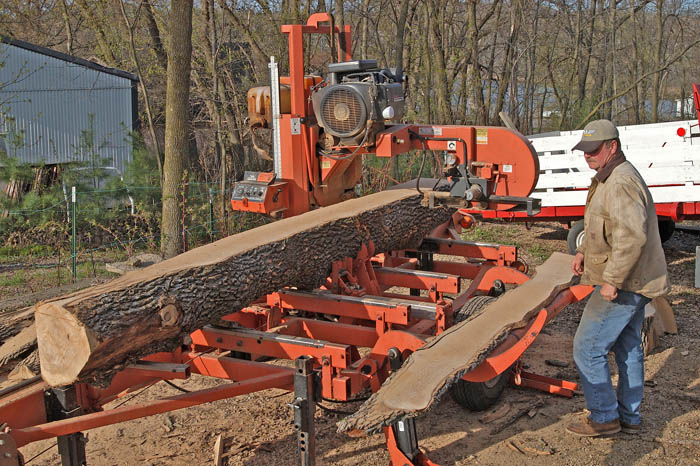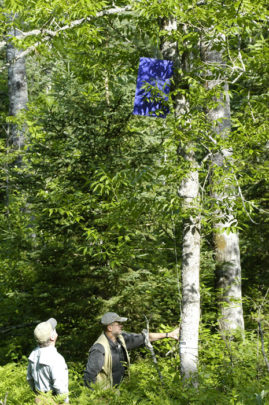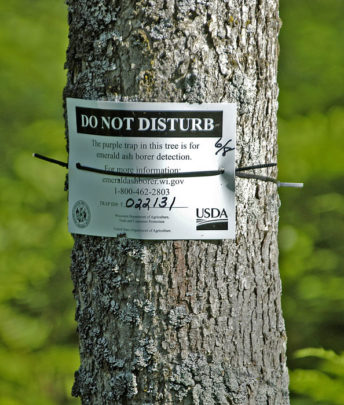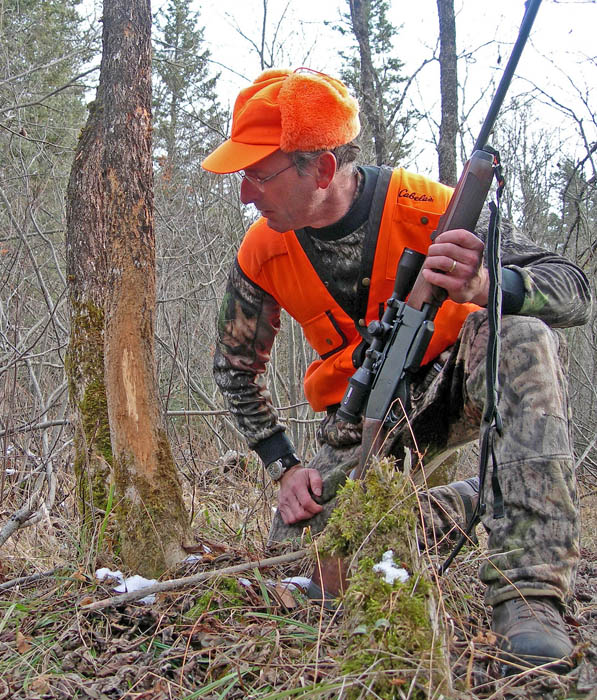First they came for our firewood, saying we couldn’t haul it to deer camp because that’s beyond the county line.
And now they’re coming for entire ash trees, chipping their beautiful wood into worthless mulch.
How much longer will Midwestern states live in such fear of the emerald ash borer that we waste our ash trees’ assets in yet another futile, expensive effort to stop a destructive insect or disease from ravaging urban and rural forests?

A sawyer cuts lumber from a log that Patrick Durkin salvaged from a dead ash tree in his yard.
Even if we could eliminate the ash borer, how much grace will we enjoy before the next bug or fungus assaults another native tree? Will we then enact more firewood bans and reduce more valuable wood to chips for paving trails and playgrounds? How long before our ash-mulch supply exceeds demand, and we simply burn or pile it to rot?
Talk about wasteful extravagance. We need to rethink this and learn something at the ash’s expense
Let’s face it: Trees die, near home and in the deer woods. If it’s not emerald ash borers, it’s Dutch elm, gypsy moths, oak wilt, spruce budworm, bronze birch borers, tornadoes and windstorms. And tomorrow it will be yet another scourge and we’ll remain just as helpless to stop it.
All we can do is craft plans that maintain sundry tree species in our towns, cities, woodlots and forests, and know many will eventually fall to bugs, blights or big blows. And when each inevitability strikes, we’ll have covered ourselves through diversity.

Purple traps like these attract emerald ash borers, which helps states, cities and counties monitor where this destructive bug is showing up as it expands its range.
Until then, how much longer should we shadow-box the ash borer, and how much value should we place on protecting its victim? Would we fret if these bugs were killing boxelder trees? We might have little or no use for boxelders, but they’re important to wildlife and for stabilizing stream banks and other erodible lands.
Personally, I hate losing the green, white and black ash trees to an ugly, invasive bug. But firewood-hauling bans are mere speed bumps to the ash borer, and who believes cities and towns can afford to inject the insecticide emamectin benzoate – trade named “Tree-äge” – into urban ash trees every two years until the trees die of old age 100 years – or more – from now.
That’s no small consideration. Madison, Wisconsin, for example, is chemically treating about 12,500 mature ash trees on its street terraces, and Milwaukee plans to treat about 28,000.
But what do we really know about Tree-äge, which has only been available since 2008? Some officials say it doesn’t harm birds, animals or insects that land but don’t feed on treated trees.
Others aren’t so certain. The Scottish Environmental Protection Agency says the pesticide is toxic to birds, mammals and fish, but shouldn’t harm the environment because it breaks down quickly.
The U.S. Forest Service says the chemical’s ecological risks are “dominated by uncertainties” because little is known about emamectin benzoate after it’s injected into ash trees. In an October 2010 risk assessment of this pesticide, the Forest Service wrote, “The inability to estimate expected exposures of nontarget species limits confidence.” In other words, no one really knows how birds and mammals are affected if they eat bark, seeds, stem tissue or insects from treated trees.

When traps for emerald ash borers are hung up, the agency responsible for it posts a sign on the trunk below.
What is certain? Well, cities like Madison and Milwaukee are removing younger ash trees – less than 8-inch diameter in Milwaukee and less than 10-inch diameter in Madison – as well as bigger ash trees in poor condition or beneath utility lines. They’re replacing them with saplings from a wider variety of tree species.
Meanwhile, many cities are wasting money and beautiful wood by chipping felled ash into mulch. Granted, ash lumber isn’t as valuable as walnut or black-cherry lumber, but most people would admire floors, trim or wainscoting made from ash that’s locally grown, harvested and milled. You’re wrong if you think it’s good only for firewood, ax handles and Louisville Sluggers.
Maybe it’s time Midwesterners connect with all of our native wood by appreciating ash trees while we still have them. For example, ash makes up about 15 percent of Wisconsin’s forests and about 25 percent of its street trees. That should allow ample opportunity to discover the incredible wealth of this natural resource.
It’s hard to believe civic leaders can’t find ways to inspire state and local businesses, school districts, church and civic groups, and Scouts and 4-H groups to make flooring, furniture, decks, benches, picnic tables and other products from ash trees.

Ash trees are common along urban streets and deep inside large forests. A buck rubbed this black ash tree in northwestern Wisconsin
Think of the jobs we could create with more locally run sawmills, wood kilns, wood mills and flooring/cabinet shops. Who wouldn’t take pride in doors, floors, chairs, stairs, tables and paneling made from hometown trees?
Rather than paying millions to chip ash trees into quick-rotting mulch, we could be making millions turning ash lumber into long-lasting symbols of civic pride.

 By
By 



